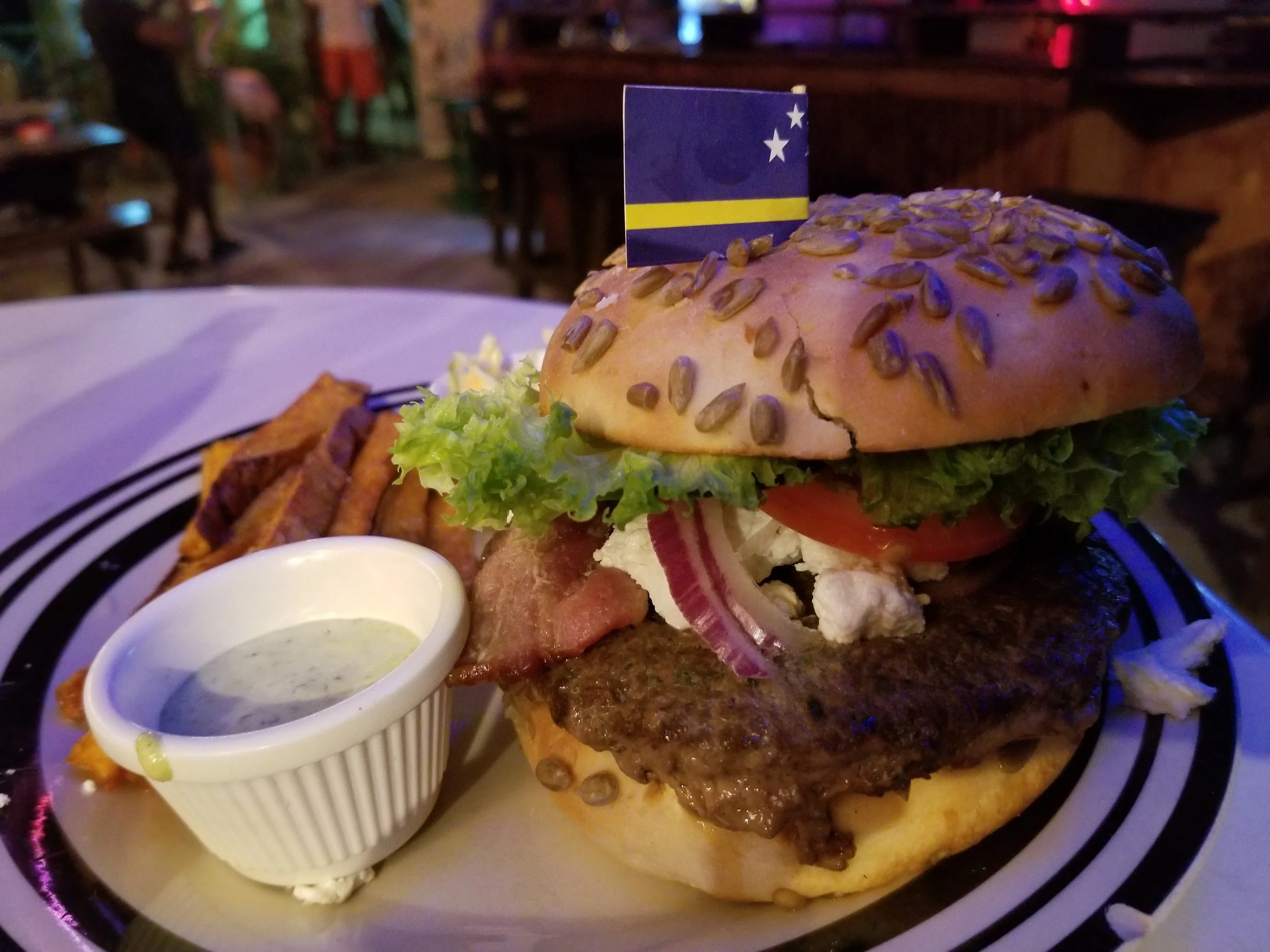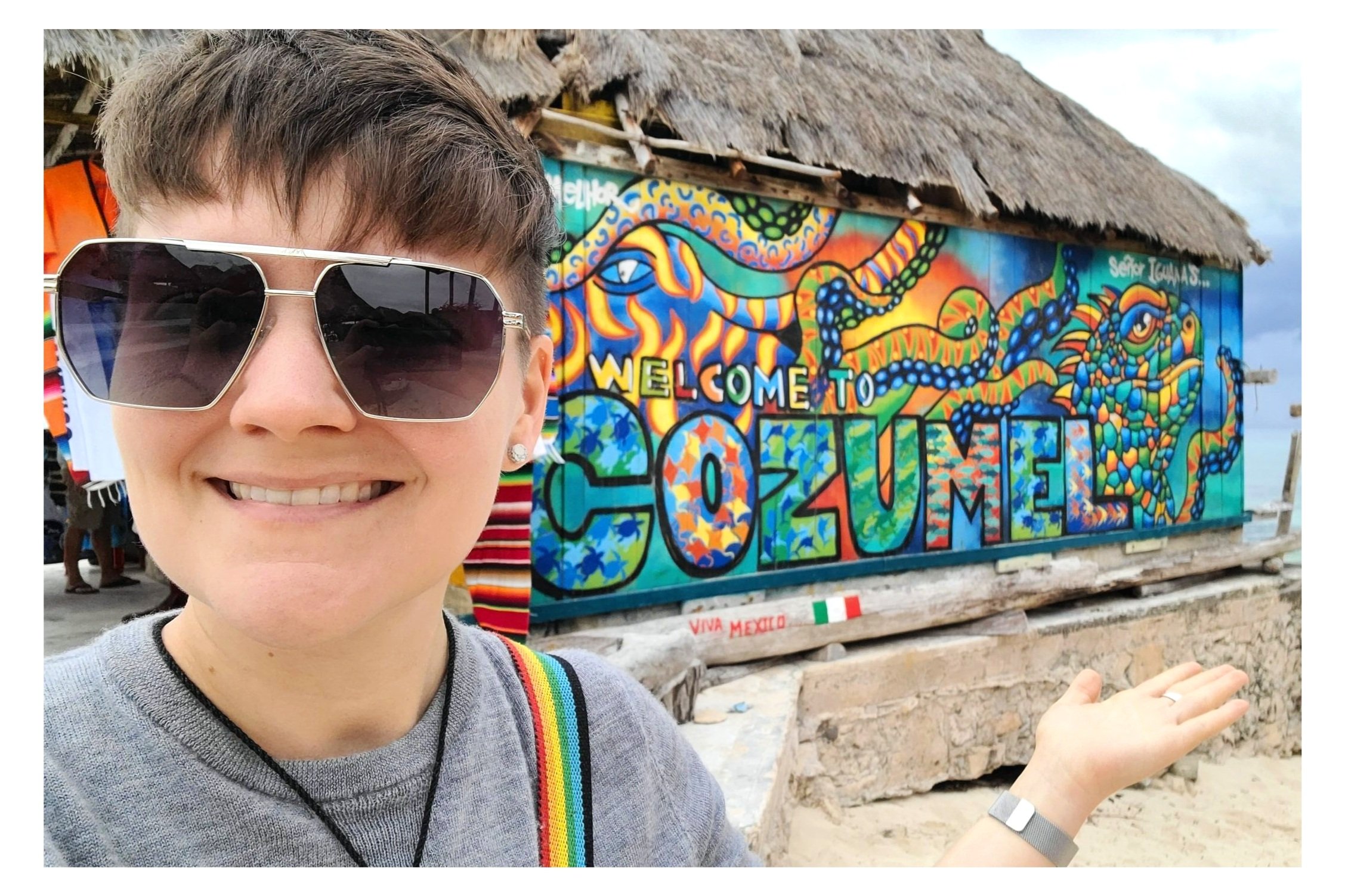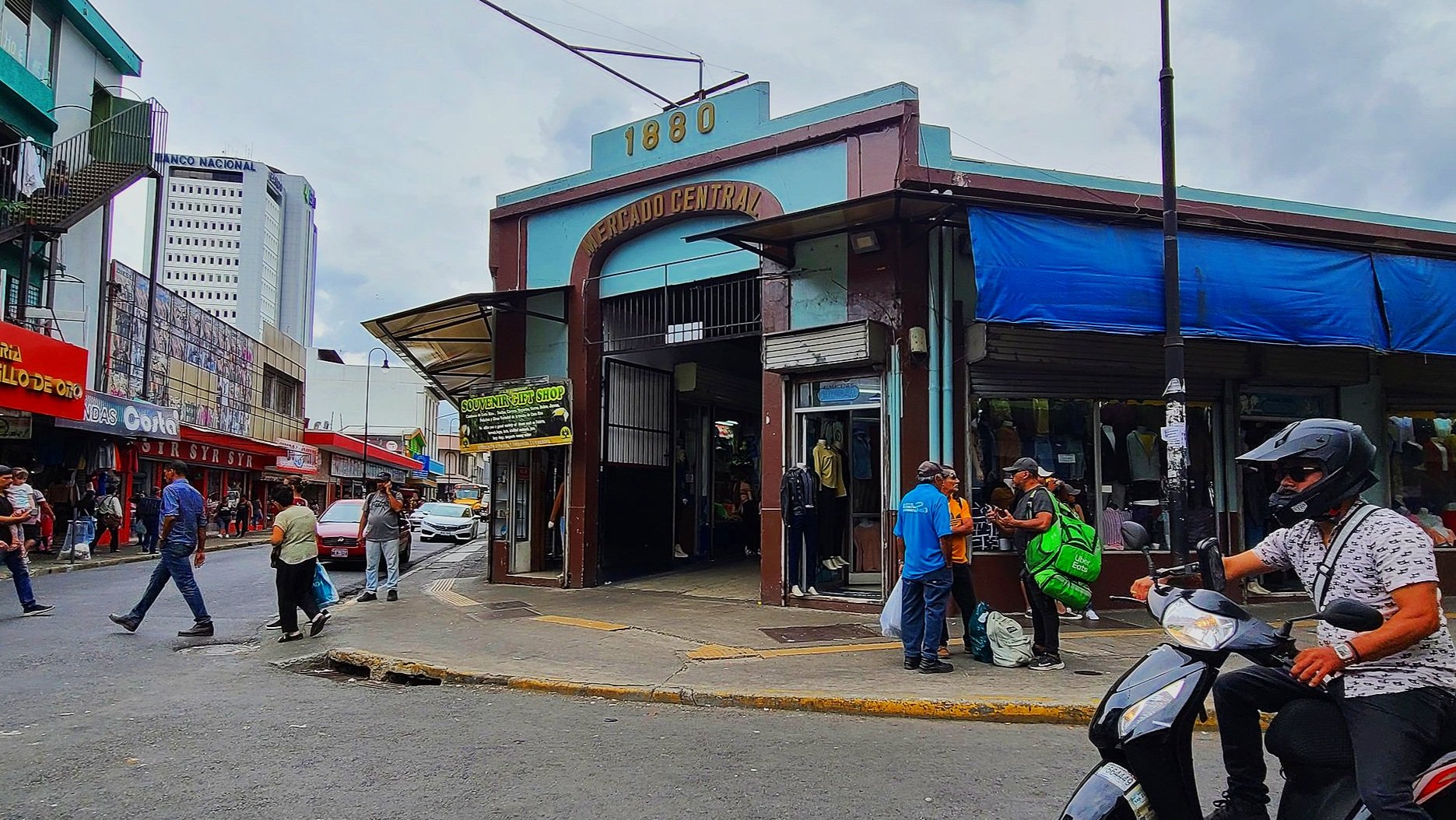My favorite way to explore a country and its culture is through its food.
I enjoyed experiencing Curaçao's unique mix of Caribbean and Dutch food through some of its restaurants, grocery stores, and other little gems I found!
Below I write all about what to eat in Curaçao, including the foods I tried (like iguana!!) and some that I (sadly) missed.
Why Grocery Stores
The grocery store was my first stop in Curaçao. Call me strange but grocery stores are usually where I like to start in a new country. In my opinion, there's no better way to experience a new culture than through its local supermarket.
Restaurants often show off the best of the best of the most quintessential and celebrated dishes and cuisine of a culture. Meanwhile, grocery stores demonstrate how locals shop and eat on any normal day.
Particularly when I am in a new country for an extended stay, it's important to me to save money on going out to eat by making my own food for as many meals as possible. But I am also eager to try new foods—especially food that is a major part of the culture of the region.
And so, in my first 24 hours, I stopped at 2 grocery stores and picked up both personal necessities and local delicacies mostly of Dutch influence.
Dutch Influence
Curaçao is a Dutch colony. Willemstad, Curaçao's capitol, was formerly a hub for the slave trade from West Africa to the rest of parts of the Caribbean and South America. You can still find slave quarters all around the island.
Dutch colonists built their fortunes off the slave trade there and settled on the island for the long haul. As a result, Dutch culture took hold over the island.
Today, there is an interesting mix of both Dutch and Caribbean food (with some African roots and South American influences) on the island.
I received recommendations to try a lot of different foods in Curaçao. The Dutch-specific foods were mostly covered by my trip to Albert Heijn. Albert Heijn is a Dutch grocery store opened in 2009 and renamed Van den Tweel in 2016.
Apparently, the name change occurred because of a disagreement with the main company in the Netherlands. It continues to sell Albert Heijn products which you can see on the food labels in some of my photos.
The following are some of the foods I was recommended to try and my take on each:
Stroopwafel
Typically eaten with a hot drink, stroopwafel is made of caramel sandwiched between two waffle cone wafers. The proper method of consumption is to place it on top of your hot beverage allowing it to melt enough that it bends and becomes easier to chew.
Just try to eat it faster than it melts and falls into your beverage, as happened to me several times!
Drop
This is a licorice candy in the form of little droplets of sticky chews. I actually really like American black licorice. But unlike American licorice, which is very sweet, drop has a strong almost bitter or savory taste at first and then it's sweet after.
It was shocking when I first tried it. I'm still not sure if I like it but somehow I keep eating them from the package every once in a while (I still have the original bag I bought pictured above!).
Hagelslag
This is basically just chocolate sprinkles! The Dutch, typically young people, have it sprinkled over buttered bread. So this is exactly how I had it while in Curaçao. What's not to love about bread, butter, and chocolate?
Gouda
The Dutch are known for their cheese—in particular gouda! Van den Tweel had the most impressive cheese sections of any store I think I have ever been to! I had to get a chunk of gouda and some yummy crackers to go with it. This was by far one of my favorite snacks to munch on during my time in Curaçao!
Verkade Chocolate
I love trying different culture's version of chocolate. Verkade is a company in the Netherlands that was founded in 1886 by Ericus Verkade. Back then it was mostly a bread company but they expanded to making chocolate later.
The chocolate was not exactly stand out but it was very good and fixed my sweet tooth craving whenever I returned from a day of exploration.
Kaassoufflé
This is one of the few Dutch foods I actually had out at restaurants. The first place I ate it was as an appetizer at Shelterrock Paradise Restaurant. I became obsessed with these little cheese-filled, deep fried rectangles of heaven. Yummmm!
Kroket
I was told I had to try Kroket specifically from a little food stop called Dutch Treats. SItuated next to the Queen Emma walking bridge in Curaçao, this spot is open late and serves up all the classic, fatty Dutch favorites. I ordered a kroket not realizing it was filled with a beef concoction (with flour, butter, herbs, etc.).
The outside is crispy, fried goodness and the middle is creamy and tasted almost cheesy. But the beef flavor was unmistakable. I don't like beef so this was a no for me but I know others love it!
Bitterballen
I got bitterballen on a plate of other Dutch yummies (pictured above in the upper right) but I didn't try them because they were definitely filled with beef. My Canadian friends loved them, though!
Missed Foods
Unfortunately I ran out of time (and meals) to try vla (pudding), pannenkoeken (pancakes), and lots of other options from Dutch Treats!
Caribbean/Curaçao Specialties
Curaçao existed at the heart of the African slave trade, it's an island country in the Caribbean, and it is found directly north of Venezuela. All of these factors play a role in its resulting cuisine.
Seafood and fresh fruit are inevitable on an island and in a tropical climate. And the African roots and Venezuelan influences can be noted in some of the most commonly found foods around.
Fresh Reef-Caught Fish
Anytime I'm visiting an island, I always make sure to order lots of seafood. In particular, the local fish caught same day is always the freshest you will have anytime, anywhere!
I had lots of different fresh fish while in Curaçao but my favorite fish experience was at Shelterrock Paradise Restaurant. I was with a couple from Canada who were happy to share their fish with me so I got to try 3 different kinds – lionfish, barracuda, and parrotfish.
The most flavorful or all of these was the lionfish. I went from seeing the lionfish on the reef the day before to eating it very happily! The fish is invasive to other species in the area, so I could also eat it knowing it was sustainably and responsibly sourced.
Coconut Roast
After my first experience at Shelterrock Paradise Restaurant, I had to go back for their special Friday coconut roast. Our waiter, who was a very funny and charismatic son of the owners, made it sound so good—and it was!
The process involved letting the owners know in advance that I would be coming so they could pick enough coconuts for the dinner.
They stuff the coconuts with rice, herbs, and your choice of vegetable, fish, shrimp, chicken, or beef. Then they slow roast them from late in the afternoon (about 3pm) until you eat around 9pm at night. I ordered the fish and shared the Canadian couple's shrimp and chicken roasts. All were excellent but the shrimp was my favorite!
The experience watching them take the coconuts off the fire and serve them up was one of my most memorable food experiences of all time! Here's a video capturing the occasion, which includes discussion about their secret spice! ;)
Iguana
When in Curaçao, you are likely to see iguana scurrying all over the rocks along the coastline. There are a lot of them! Naturally, they became a food source for locals and now its a unique food to try. Jaanchie's is the place to go for it. They give you fair warning ahead of time—iguana is very boney!
Iguana tastes like chicken—really! The experience of eating it is similar to lobster. Like cracking away at lobster shell, it's a lot of work picking all the bones out. But I'm glad I tried it!
Funchi
This side dish with African roots is made from cornmeal and is almost like polenta. It's usually served with cheese melted on top. Nothing not to love here!
Goat Burger
Goat is a popular food source in Africa and so Curaçao is home to many goat-based dishes such as stews. For instance, you can get stuba (goat stew) from Jaanchie's (the iguana place) or from the Old Market or the Green House in Willemstad.
But everyone told me I should go for the infamous goat burger at Williwood. According to the chefs, the “williburger” has been perfected over several years. It comes with goat cheese and bacon on it and it truly was perfection!
Also, you can feel extra good eating it because partial proceeds from purchase of the goat burger go directly to the Williwood Youth Movement. This is an organization that will set up a farm/school for young people to learn how to become entrepreneurs! Yay Williwood!
Pumpkin Pancake
Zus di plaza offers lots of quintessential Curacao food such as goat stew and fresh fish. You can get any of these items there and know it’s authentic, local cuisine made to perfection! But one of the most unique and famous items on the menu is their pumpkin pancake! Make sure to order one to top off any meal!
Missed Foods
Food truck stops are all over Curaçao selling mostly meat items (usually goat). And the Venezuelan influence continued with food like arepas (a kind of pita stuffed with cheese, meat, avocado, etc.)
Alcohol
I don’t typically drink a lot when I travel, but I love trying location-specific beverages when they are particularly unique to the area. Curaçao happens to have quite a few options in this area!
Blue Curacao
Known all over the world, Blue Curaçao is traditionally made from citrus peels and a local fruit called lahara (a Curaçao orange).
This liqueur is high quality enough to sip straight. I had it in a cocktail called a “Blue Lagoon.” It was strong and sugary and delicious!
Ròm Berde (Green Rum)
This is another unique, Curaçao liqueur found only at Netto Bar. Founded in 1954, Netto Bar is the only place where you can take shots of it.
My Airbnb host, Muni, took me here specially to try it. While their website explicitly welcomes locals and folks from abroad "irrespective of nationality, race, religion, social position and/or political preference" there were no other white folks hanging out here. There was predominantly black Caribbean locals who were very excited to see my seemingly wimpy white self down some green rum like a champ!
I love being introduced to authentic, local spots like this that aren't overrun with tourists! Oh, and the music was also local and awesome!
Zulia
This Venezuelan beer is the perfect, low cost alcoholic beverage to polish off a long day as you watch the sunset.
Other Things I Ate
Here is a quick, mostly photographic run-down of the many other yummy foods I ate in Curaçao:
Fresh Fruit & Smoothies
When in a tropical climate, I always drink a lot of smoothies and eat tons of fresh fruit. I loved the papaya which I had fresh every day with yogurt. I also enjoyed the smoothies from a spot next to the Queen Emma bridge.
I chopped a pineapple up on top of a slab of coral rock at the beach. Although probably not native to Curaçao, it’s a staple in my diet and this one was super fresh and delicious!
Coconut Water
You’d think coconut water would be in abundance on Curaçao. Alas, the only fresh coconut I found was on my last day served at the floating market in Willemstad. Boats come over from Venezuela to sell food and trinkets in this section of town along the water. This one was not the sweetest I’ve ever had, although the coconuts in Niue are hard to beat!
Yucca Fries
One night when the highly recommended Golden Star Restaurant was closed, I went to a local chain called Larry's. I ordered shrimp and yucca fries. It was the first time I ever tried yucca fries and they were great! I'm not a big fan of french fries but I was a fan of these.
Meals from Bahia
One of my favorite restaurants was Bahia next to Laguna Beach. I probably would have loved this place just for its location—the beach and sunsets here were gorgeous! But the food made this place even better. I had 2 meals here and both were outstanding.
One was just simple pasta with a creamy pesto sauce and the other was a chicken kebab dish. I cannot say enough how well cooked and tasty these meals were. I imagine their entire menu meets the same standards!
In Conclusion
As a big foodie, I traveled to Curaçao and had an amazing food experience. It was a wonderful coming together of many different cultures and influences. This made for no lack of food adventuring. From Dutch Kaassoufflé to goat burgers, I enjoyed every part of my food adventure in Curaçao!







